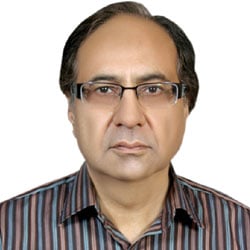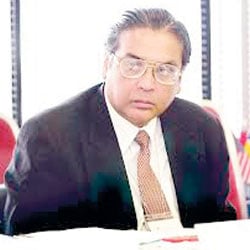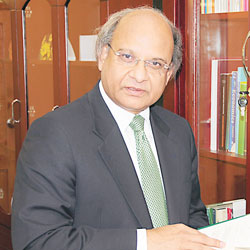The federal budget for 2017-18 pledges very little to spur the much needed real growth but does speak of an expansionary and very inflationary budget that is bound to further increase the fiscal deficit which is fast getting unsustainable.
INSIGHT

The federal budget for 2017-18 pledges very little to spur the much needed real growth but does speak of an expansionary and very inflationary budget that is bound to further increase the fiscal deficit which is fast getting unsustainable.
The million dollar question, nonetheless, is how would the government fund its new budget? The Pakistan Muslim League-Nawaz administration led by Prime Minister Nawaz Sharif pulled through the outgoing financial year by getting printed Rs1 trillion currency notes from the central bank.
For the fiscal year of 20017-18, the government has no magic wand to manage resources. It is, apparently, left with only one option of once again resorting to deficit financing (printing of notes) proximately amounting to Rs1.2 trillion to Rs1.4 trillion to manage its pressing financial needs.
As long as the government remained with the International Monetary Fund (IMF) under a three-year $6.6 billion Extended Fund facility (EFF), it was not allowed by the Washington based lending agency to seek deficit financing. But as soon as the IMF programme ended in October 2016, the government went for Rs1 trillion deficit financing from the central bank as there was no oversight by any local or foreign agency.
Under these circumstances independent economists maintain that fiscal deficit target of 4.2 percent set in the new budget is destined to jump to minimum six percent and thus trigger runaway inflation. This is not being ruled out that the single digit inflation could go into doubt digit.
Collecting resources both internal and external seems a formidable task during the days ahead. Questions are being asked how would the government collect Rs4 trillion tax revenue when over Rs200 billion revenue shortfall is expected to occur by June 30 this year. Next year too there is a fear that there will be Rs200 billion revenue shortfall especially when the government has allowed a number of tax breaks on machinery imports.
Non tax revenue has been shown on the higher side despite the fact that there was a reduction in Coalition Support Fund (CSF) from the United States. The government was supposed to receive Rs170 billion under CSF programme during 2016-17 but actually Rs64 billion were disbursed by the US government. For 2017-18, the government is expecting Rs147 billion through CSF programme which seems very difficult, if not impossible under President Donald Trump’s government.
The government is allegedly to have changed the revenue base by increasing its expenditure during the last quarter of the outgoing financial year. Moreover, no provision is shown in the new budget about Rs125 billion kept for increase in salaries and pensions.
“History is repeating itself as no course correction is being adopted and the government as usual has worked out its new budget without doing a proper exercise,” said the renowned economist and former finance minister Dr Hafiz Pasha.
“I really do not know whether this is a real or elusive budget,” he said, adding that the government has started doing deficit financing ever since it came out of the IMF programme which is not good for the economy.
He did not believe that the government could get required revenue because of making unrealistic projections and that the new budget was bound to cause more inflation as it entailed expansionary policies.
Dr Pasha was of the view that it was good that the government had announced Rs180 billion massive export enhancing package last year. “But then there will be more growth in imports due to CPEC-related machinery imports and this would cause increasing trade imbalance,” he added.
It was largely expected that budget deficit would start coming down at the end of three years IMF programme particularly when the government kept its deficit target at 3.8 percent of GDP in the outgoing financial year. The objective was to ensure that there was no unrealistic rise in public debt.
But if one looks at the details of first ten months, the budget deficit is increasing and going to be 6 percent (over Rs2 trillion) significantly up from the last year level.
This deficit has increased due to a number of reasons including the rise in oil prices. There is no windfall gain available due to unprecedented oil prices coming down from over $140 a barrel to $27 which are now again increasing and likely to be $60 a barrel during the next financial year.
Another prominent economist and former special secretary ministry of finance Dr Ashfaque Hasan Khan was also critical of the government and said the new budget has been presented in an environment of extreme political uncertainty in the country. Its implementation, therefore, he said, will be a challenging task for the government.
“It is an election budget as well as a slogan budget,” he said, and added that for the first time in the history of Pakistan, Rs1 trillion development budget has been announced, and hastened to add, “the government cannot have so much money for development which is why I call it an election budget only to fool people”.
Dr Khan said revenue was grossly overstated while expenditure was grossly understated to achieve a slogan oriented budget deficit target, the lowest deficit shown in the last ten years. “But at the end of the day, we will be standing at the same level of 2013 to post a minimum six percent budget deficit in 2017-18.”
The government, he pointed out, started with 6.2 percent budget deficit, and after five years with the IMF was facing the same balance of payment problem. Achieving Rs4 trillion revenue collection target with current Rs3,521 billion base would be impossible to manage, he said.
“There was just 7.3 percent revenue growth during the first ten months of the current financial year. The important question now is can the government collect Rs1,000 billion in less than two months to arrive at a revised revenue collection target of Rs3,521 billion,” Dr Khan asked.
Independent economist maintain that the next financial year would witness more financial problems in the absence of reduced CSF funds, continued reduction in central bank’s profit, increase in the cost of debt servicing due to constant appreciation of dollar, seen and unforeseen increase in security expenditure in the wake of significant increase in Raddul Fasaad operation, and the tariff differential subsidy. All these projections could increase the size of the federal budget to over Rs5 trillion with net revenue receipt of Rs2.9 trillion.
The increasing gap between income and expenditure is causing a real problem as no real efforts were being made to explore new resource mobilisation except to burden people with more direct and indirect taxes. The ratio between direct and indirect tax is still 40:60 the major burnt of which is born by the common people who pay tax on every item including a match box, phone cards, eggs, milk etc.
The government continues to claim that it has not imposed many taxes, and the poorer sections have been spared from these. The reality is different, as there are more and more indirect taxes. Also, nobody knows as when the government will announce mini budgets during the next financial year, starting July 1, 2017.
Like always, the government this time too avoided to adequately tax agriculture income which could help achieve substantial resources. It can help, provided tax on agriculture becomes a federal subject through legislation; something both Pakistan Peoples’ Party and PML-N don’t want to do.
Pakistan Tehreek-e-Insaf does support adequate tax on agriculture sector which still forms part of 23 percent of the country’s $300 billion plus economy. Why there is no political will to bring agriculture sector in the tax net? All previous governments deliberately avoided tax on agriculture income due to their own vested interest - 70 percent of MNAs and MPAs belong to the rural areas. They always joined hands, whether belonging to PPP, PML-N or PML-Q, against the issue in the parliament. Worst rivals of each side become considerate to each other when it comes to taxing agriculture income.
Resultantly, poor, including the middle and lower income groups, are forced to help raise revenue by giving increasing amount of taxes. Besides they have to pay for all coming indirect taxes which have no limits. Those who are influential can always get away without paying their due taxes; they can get their loans written off; get targeted and untargeted subsidies and tax breaks, and can have a windfall gain by indulging in corrupt practices.
There is no dispute among the concerned quarters that the outgoing financial year witnessed a huge decline in external inflows due to deterioration in exports on one hand and an exceptional surge in imports on the other hand. This caused close to $8 billion current account deficit in 2016-17 compared to $2.378 billion in 2015-16. This mainly happened when exports had gone down to less than $22 billion compared to $25 billion in 2013-14, a decline of over 12 percent in two years.
Going forward, without curtailing expenditure and increasing the gaping income, there is no way to get rid of the fiscal deficit which no doubt is the number one economic problem yet to be dealt with honestly and professionally. Legislators confess that the current political system does not allow them to be fair and they are helpless about reforming the system.
The writer is a senior journalist based in Islamabad

“I really do not know whether this is a real or elusive budget. The government has started doing deficit financing ever since it came out of the IMF programme which is not good for the economy.”
Dr Hafiz PashaFormer finance minister

“There was just 7.3 percent revenue growth during the first ten months of the current financial year and the important question is whether the government can collect Rs1,000 billion in less than two months to arrive at a revised revenue collection target of Rs3,521 billion.”
Dr Ashfaque Hasan KhanFormer special secretary ministry of finance